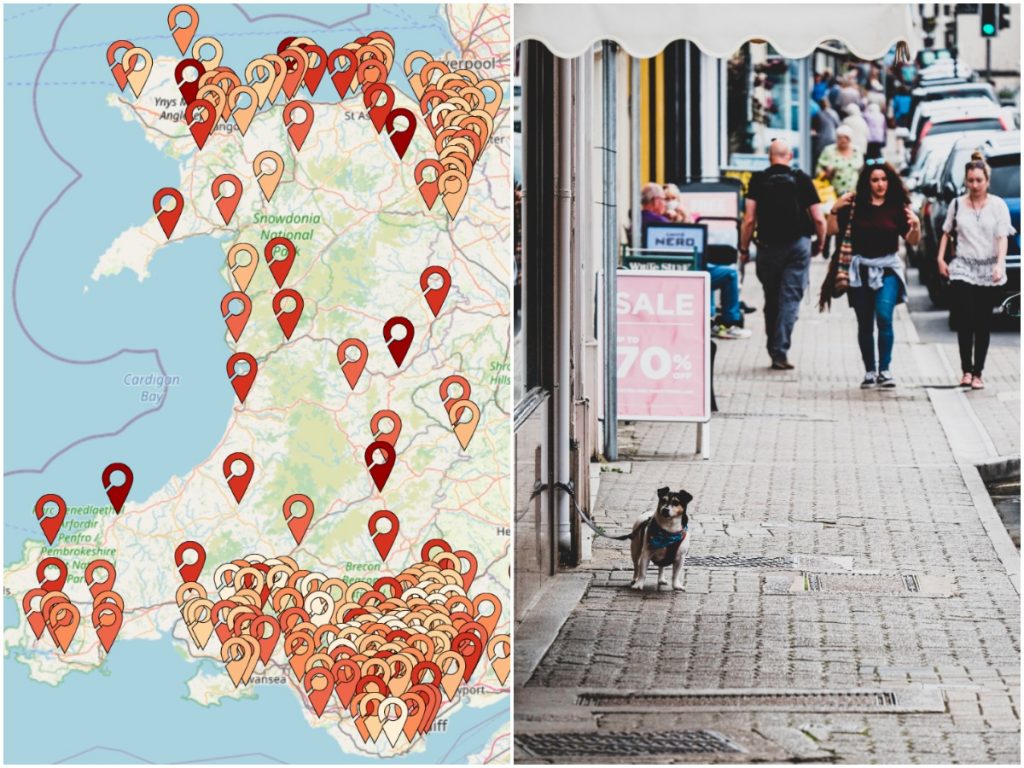Ellen Jones looks at how getting a deeper, data-driven understanding of our towns can turbo-charge grassroots regeneration.
A year ago when the IWA launched the Understanding Welsh Places website, the fact that our lives would be so dramatically different in 2020 was not even a glimpse in our mind.
At the outset of the project, colleagues commented that Understanding Welsh Places is an unusual project for a think tank like the Institute of Welsh Affairs. We are usually a home for agenda-setting reports with lists of recommended policy changes for the Government to enact.
A bilingual website that presents and analyses open data about towns, larger villages and cities in Wales is a step in a different direction.
However, through the fog of the pandemic, the importance of projects like Understanding Welsh Places has become ever clearer. Covid-19 has highlighted the importance of where we live, who lives in our communities, where we get our food, and where we access our local services.
For better or worse, the pandemic has meant most of us are getting to know our immediate surroundings better than we may have before. We may be noticing for the first time how much we have on our doorstep, or noticing what our places are missing.
“If Pembroke is more similar to Bethesda than it is to Tenby, then it makes sense for planners in Pembroke to make links with colleagues in north Wales rather than those to the east.”
We believe in empowering communities by giving them the tools they need to make changes and, to encourage this, in the second week of November we are hosting the Understanding Welsh Places Festival. This is a series of online events supporting and inspiring local communities, decision-makers, planners and policy-makers to make positive changes to the places where they live and work.
The sessions will equip people with the knowledge and tools they need to better understand their place and encourage them to enact the change they want to see. And speakers from towns who have used the tool to power their community led regeneration plans will tell their stories about the value of local data.
10am, Tuesday, 10 November – Understanding the data of your place
10am, Wednesday, 11 November – Shaping the future of our towns and communities
10am, Thursday, 12 November – Telling the story of your place
By presenting data and analysis at the level of towns rather than that of local authorities, the site is designed to provide town and community councils, charities, social enterprises, community groups, planners and place makers with the information they need to identify opportunities in their areas, bolster funding applications, develop community plans and place plans and undertake many other activities besides.
This focus on grassroots planning and action is in keeping both with the IWA’s own commitment to supporting a strong, confident democracy in Wales and with the project’s funders Carnegie UK Trust’s work on the ‘enabling state’, which examines ‘the paradigm shift that is transforming the UK welfare state to an enabling state’, advocates for a move from ‘top down to bottom up’ and places an emphasis on co-production.
The project has also benefited from the knowledge and local networks of experienced regeneration consultants and organisations such as One Voice Wales (the umbrella body for Welsh town and community councils), the Federation of Small Businesses and the Wales Centre for Voluntary Action, who have given time freely to the collaborative undertaking.
Moreover, the Centre for Local Economic Strategies (CLES) was contracted to develop the site’s inter-relationship assessments, which indicate the extent to which places rely upon neighbouring towns for public, commercial and social assets; the relative ‘independence’ or ‘dependence’ of a place.
The method used to create these assessments is informed by CLES’ experience in the field of community resilience: the Centre is heavily involved in the emerging discussion around the ‘foundational economy’ and was part of the creation of the ‘Preston model’, probably the most high-profile example of this new approach to local economic development.
Gofod i drafod, dadlau, ac ymchwilio.
Cefnogwch brif felin drafod annibynnol Cymru.
As part of its work on the site, the Wales Institute for Social and Economic Research, Data and Methods (WISERD) team created an informative typology that puts every Welsh place with more than 2,000 residents into one of seven categories based on its demographic, social and economic characteristics.
When presented on a map, these categorisations foreground some surprising similarities between places: for example, it shows Flint to be more similar to Caerphilly, Caernarfon more similar to Haverfordwest than it is to Porthmadog.
The website’s features include the ability to compare statistics for different places and the site encourages users to investigate similarities. If Pembroke is more similar to Bethesda than it is to Tenby, then it makes sense for planners in Pembroke to make links with colleagues in north Wales rather than those to the east.
“At its essence, Understanding Welsh Places is about people, communities, and collaboration.”
Understanding Welsh Places has the potential to challenge stereotypes and to encourage productive conversations and the sharing of best practice between communities, towns and villages that may never have thought of themselves as similar.
Although a lot of hard work has already gone into Understanding Welsh Places, the project still has further to go. Several new datasets will be added to the website before the end of 2020, including information on levels of cultural participation in each place and on access to assets such as libraries, leisure centres and greenspace.
The commuter mapping tool will be improved by more recent and detailed data, changes within places over time will be analysed, and more qualitative descriptions of towns and villages will be added.
Looking past the data and the maps, at its essence, Understanding Welsh Places is about people, communities, and collaboration.
We want communities to share their plans and research to inspire others across Wales. If your place is ready to inspire – or in need of inspiration – Understanding Welsh Places is ready for you.
If you would like more information please contact [email protected]
All articles published on the welsh agenda are subject to IWA’s disclaimer.





